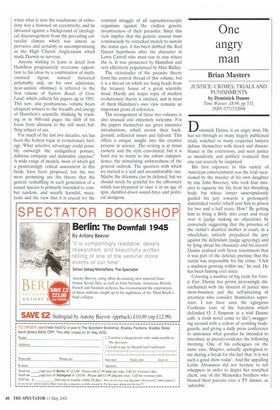The perils of interference
Hugh Lawson-Tancred
NARROW ROADS OF GENE LAND: VOLUME TWO, THE EVOLUTION OF SEX collected papers of W. D. Hamilton OUP, £50, pp. 928, ISBN 0198503369 If all those who must be kept alive by elaborate medication during their childbearing years are so kept alive and duly bear children, then the genes which cause their condition will also be passed on to the next generation. The likely effect of this over several generations will be that the defective genes become widespread or even universal in the population as a whole. What, then, if the elaborate medication is abruptly removed by some infrastructural or other catastrophe? This is the Planetary Hospital scenario which W.D. Hamilton holds up as a warning to our current practice of passive dysgenics. The remedy, in theory, is to intervene in the germline itself and excise the root of the problem. But even if we make the large assumption that this is, even in principle, possible, there are two problems: will we not eventually produce homogenised humans with effectively identical doctored genes in a world drained of individuality and flair, and may it not be the case that a gene that is currently harmful to its carrier may, in some unforeseeable future context, become a life-saver?
The British have a penchant for neglecting their genuinely original thinkers, which is almost as vexatious as our converse habit of (temporarily) elevating mediocrities, Hamilton is a conspicuous example of the first category, having possessed arguably the most powerful and original mind in biology since Darwin. It was Hamilton who developed and presented a theory of the genetic basis of altruism which led to the inexorable rise of kin selection over group selection and the sociobiological revolution, later brought to the notice of thinking people by Ed Wilson. Richard Dawkins and Steve Pinker, amongst many others. Moreover, he started to do so back in 1964, when what is now the touchstone of orthodoxy was a frowned on eccentricity, and he laboured against a background of ideological discouragement from the prevailing culturalist climate which was almost as pervasive and certainly as uncompromising as the High Church Anglicanism which made Darwin so nervous.
Anyone wishing to learn in detail how Hamilton progressively overcame opposition to his ideas by a combination of mathematical rigour, natural historical polymathy and, on his own admission, near-autistic obstinacy is referred to the first volume of Narrow Roads of Gene Land, which collects his papers up to 1981. This new, alas posthumous, volume bears eloquent witness to the breadth and energy of Hamilton's scientific thinking by tracking in its 900-odd pages the shift of his focus from altruism to the still more baffling subject of sex.
For much of the last two decades, sex has been the hottest topic in evolutionary biology. What selective advantage could possibly outweigh the undignified posture, dubious company and damnable expense? A wide range of models, most of which get a penetratingly critical assessment in this book, have been proposed, but the two most promising are the theory that the genetic reshuffling in each generation of a sexual species is primarily intended to combat random, and usually harmful, mutations and the view that it is crucial for the constant struggle of all supramicroscopic organisms against the endless genetic inventiveness of their parasites. Since this view implies that the genetic arsenal must continuously be restocked merely to sustain the status quo, it has been dubbed the Red Queen hypothesis after the character in Lewis Carroll who must run to stay where she is. It was pioneered by Hamilton and very effectively popularised by Matt Ridley.
The vicissitudes of the parasite theory form the central thread of this volume, but it is a thread on which are hung beads from the treasure house of a great scientific mind. Hardly any major topic of modern evolutionary theory is omitted, and in most of them Hamilton's own view remains an important point of reference.
The arrangement of these two volumes is also unusual and extremely welcome. For the papers themselves are given extensive introductions, which review their background, collateral issues and fall-out. This offers a unique insight into the creative process in science. The writing is at times esoteric and the style convoluted, but it is hard not to warm to the robust independence, the stimulating awkwardness of the general outlook. The question with which we started is a real and uncomfortable one. Maybe the dilemma can be defused, but we should surely be grateful for the effrontery which was prepared to raise it in an age of spin, dumbed-down sound-bites and political analgesia.







































































 Previous page
Previous page